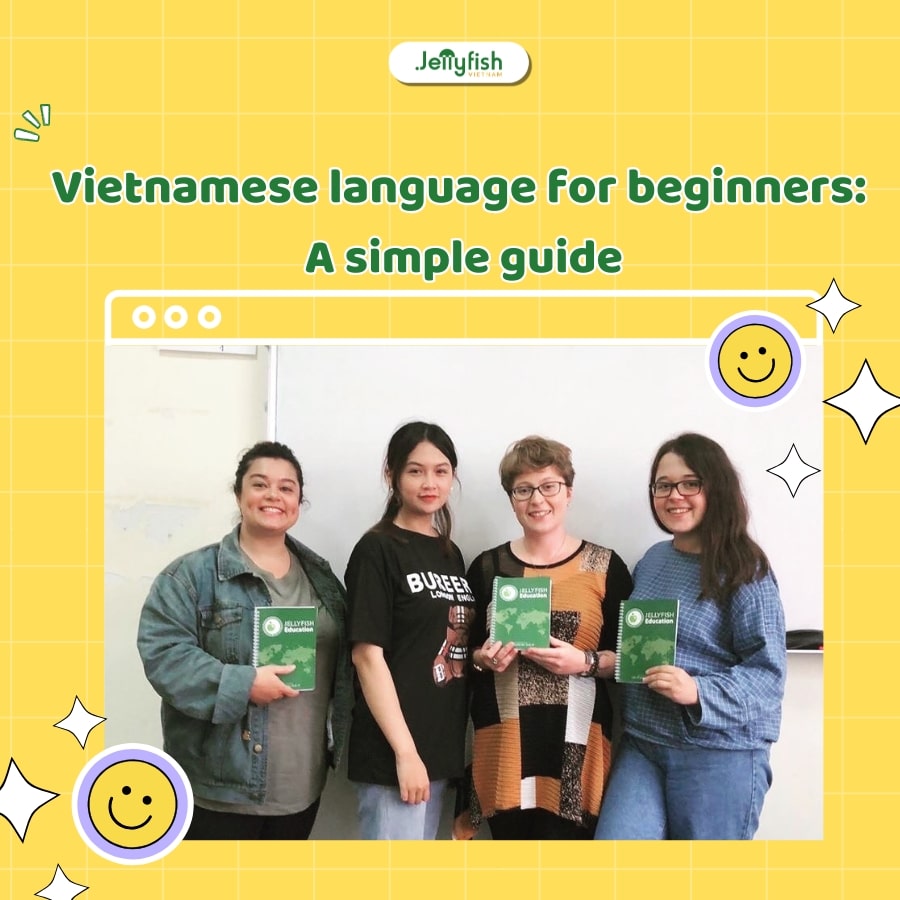Vietnamese language for beginners may seem challenging at first, especially due to its tones and unfamiliar grammar. However, with the right method and mindset, learning Vietnamese can be a fun and rewarding journey. In this guide, Jellyfish will walk you through the essentials from pronunciation and basic phrases to cultural tips so you can start your Vietnamese learning experience with confidence.

1. Mastering Vietnamese pronunciation: Tones matter
One key challenge for beginners is mastering Vietnamese pronunciation, especially the six tones in Northern Vietnamese (and five in Southern).
- Vietnamese is a tonal language, which means the same word can have different meanings based on pitch.
- Practice slowly with audio or video resources; mimicking native speakers helps.
- Focus on common sounds and tone marks like “á”, “à”, “ả”, “ã”, “ạ”.
- Apps like Duolingo or YouTube channels can be helpful in the early stages.
2. Essential Vietnamese phrases for beginners
Here are some must-know phrases that every Vietnamese language beginner should start with:
- Xin chào – Hello
- Cảm ơn – Thank you
- Tôi tên là… – My name is…
- Bạn khỏe không? – How are you?
- Bao nhiêu tiền? – How much is it?
- Tôi không hiểu – I don’t understand
- Giúp tôi với! – Help me, please!
These are useful in daily conversations and build your confidence as a beginner in Vietnamese.

3. Vietnamese grammar tips for beginners
The good news is: Vietnamese grammar is simpler than many languages. Here’s why:
- No verb conjugation: the verb doesn’t change based on tense.
- No plural forms or articles: one word works for both singular and plural.
- Word order is subject-verb-object, similar to English.
- Context and time markers (like “hôm qua” – yesterday) indicate tense.
4. Cultural tips when learning Vietnamese
When learning Vietnamese for beginners, culture matters too. Knowing how to behave and speak politely makes a difference.
- Use “ạ” or “dạ” to show politeness, especially with elders.
- Address others properly by age and status (e.g. chị, anh, cô, chú).
- Learn basic Vietnamese customs – taking off shoes, using two hands to give/receive items, etc.
- Practice listening in real-life settings: TV, music, markets, cafés.
5. How to build your Vietnamese vocabulary as a beginner
As a beginner, growing your vocabulary is key to daily communication. You don’t need to memorize thousands of words—just start with practical, high-frequency ones.
- Learn words by topic: Start with categories like food, transportation, greetings, and directions.
- Use flashcards or apps like Anki or Memrise to review daily.
- Practice vocabulary through context, such as watching videos or reading dialogues.
- Keep a personal word journal where you write down 5 new words each day and try to use them.
This approach keeps learning consistent and manageable, perfect for Vietnamese language beginners.
Conclusion
Learning Vietnamese language for beginners doesn’t have to be overwhelming. With a few basic phrases, a good grasp of pronunciation, and understanding of the culture, you’ll be well on your way to holding simple conversations and connecting with locals in a meaningful way.
At Jellyfish, we specialize in teaching Vietnamese language for beginners through interactive lessons, cultural immersion, and real-life practice. Whether you’re traveling, working in Vietnam, or simply curious, we make Vietnamese learning easy and fun.
👉 Explore our Vietnamese for Beginners course here: Jellyfish Vietnamese Course
Please leave your information via the registration form, we will contact you!
👉👉 Learning Vietnamese – Jellyfish Vietnam
✦ Hotline: 096 110 6466
✦ Head office: 1st Floor, Web3 Tower Building, Alley 4 Duy Tan Street, Cau Giay District, Hanoi
✦ Branch office: 2rd Floor, SH5.11 Vinhomes Marina, Vinh Niem, Le Chan, Haiphong
✦ Head office in Japan: 4F Westhill Building, Nishigotanda 2-24-4, Shinagawa, Tokyo, Japan


